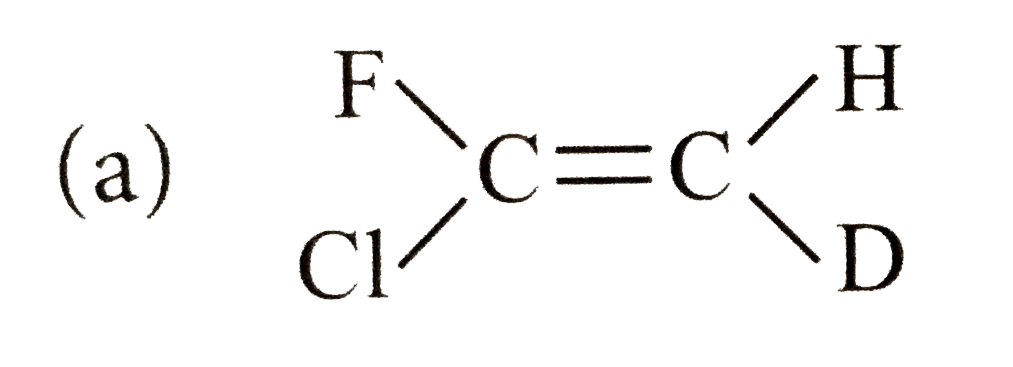Which of the following will form geometrical isomers?


all of these
The correct Answer is:A
To determine which compounds can form geometrical isomers, we need to understand the conditions necessary for geometrical isomerism, specifically cis-trans isomerism. This typically occurs in compounds with restricted rotation around a double bond or in cyclic structures, where different groups can be arranged differently around the bond or ring.
1. Identify the Compounds:
We need to analyze the given compounds to see if they can exhibit geometrical isomerism. The compounds mentioned are:
- 1,2-dichlorocyclobutane
- Oxyme (oxime)
- Cyclodecene
2. Analyze 1,2-Dichlorocyclobutane:
- This compound is a cyclic structure with two chlorine atoms attached to adjacent carbon atoms (1 and 2).
- Due to the cyclic nature, there are two possible arrangements for the chlorine atoms:
- Cis: Both chlorine atoms on the same side of the ring.
- Trans: Chlorine atoms on opposite sides of the ring.
- Conclusion: 1,2-dichlorocyclobutane can form geometrical isomers.
3. Analyze Oxyme:
- An oxime has the general structure R1R2C=NOH, where R1 and R2 can be different groups.
- The presence of a double bond between carbon and nitrogen restricts rotation, allowing for cis and trans configurations depending on the groups attached to the carbon and nitrogen.
- Conclusion: Oxyme can also form geometrical isomers.
4. Analyze Cyclodecene:
- Cyclodecene is a cyclic alkene with a double bond. The double bond can also lead to cis and trans configurations.
- Depending on the positioning of substituents around the double bond, it can exhibit both cis and trans forms.
- Conclusion: Cyclodecene can form geometrical isomers as well.
5. Final Conclusion:
- All three compounds (1,2-dichlorocyclobutane, oxyme, and cyclodecene) can form geometrical isomers.
Final Answer:
All of the given compounds can form geometrical isomers.
---
We need to analyze the given compounds to see if they can exhibit geometrical isomerism. The compounds mentioned are:
- 1,2-dichlorocyclobutane
- Oxyme (oxime)
- Cyclodecene
- This compound is a cyclic structure with two chlorine atoms attached to adjacent carbon atoms (1 and 2).
- Due to the cyclic nature, there are two possible arrangements for the chlorine atoms:
- Cis: Both chlorine atoms on the same side of the ring.
- Trans: Chlorine atoms on opposite sides of the ring.
- Conclusion: 1,2-dichlorocyclobutane can form geometrical isomers.
- An oxime has the general structure R1R2C=NOH, where R1 and R2 can be different groups.
- The presence of a double bond between carbon and nitrogen restricts rotation, allowing for cis and trans configurations depending on the groups attached to the carbon and nitrogen.
- Conclusion: Oxyme can also form geometrical isomers.
- Cyclodecene is a cyclic alkene with a double bond. The double bond can also lead to cis and trans configurations.
- Depending on the positioning of substituents around the double bond, it can exhibit both cis and trans forms.
- Conclusion: Cyclodecene can form geometrical isomers as well.
- All three compounds (1,2-dichlorocyclobutane, oxyme, and cyclodecene) can form geometrical isomers.
All of the given compounds can form geometrical isomers.
Similar Questions
Knowledge Check
- Question 1 - Select One
Which of the following pairs are geometrical isomers?
A1. B2.
B2. C3.Both of theseD4.None of the above
C3.Both of theseD4.None of the above - Question 2 - Select One
Which of the following will not show geometrical isomerism ?
A B
B C
C D
D
- Question 3 - Select One
Which of the following will not show geometrical isomerism?
A B
B C
C D
D
Which of the following will exhibit geometrical isomerism?
View SolutionWhich of the following will not show geometrical isomerism?
View SolutionWhich of the following will not show geometrical isomerism?
View SolutionWhich of the following will not show geometrical isomerism?
View SolutionWhich of the following will not show geometrical isomerism ?
View Solution

